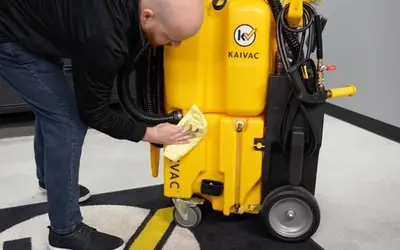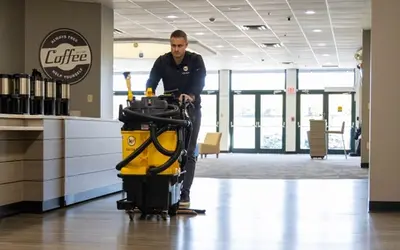How to Clean to Improve Indoor Air Quality

Cleaning to improve indoor air quality creates healthier spaces for everyone. Indoor air quality (IAQ) describes how the air inside a space can affect health, comfort, and ability to work. Considering we spend about 90 percent of our time indoors, IAQ is vital for health, wellness, and productivity.
Some IAQ factors can be improved by cleaning the air. Improved HVAC systems and portable air purifiers remove toxins like formaldehyde, lead, and smoke. Other factors, like controlling allergens, dust, and mold are best addressed by smart cleaning practices.
Here’s how to clean to improve indoor air quality in your buildings.
Risks of Bad IAQ
Poor indoor air quality has been linked to a variety of serious issues. The World Health Organization found that nearly seven million people die prematurely each year because of ambient and household pollution. Most of this however is due to using dirty fuels like coal, wood, and biomass stoves in developing countries.
While not as deadly, the poor IAQ is found in the most modern buildings. In fact, contemporary construction methods, like creating tight, energy-efficient building envelopes or using synthetic materials, contribute to the problem. Effects on human health include:
- Irritation of eyes, nose, and throat
- Headaches, dizziness, and fatigue
- Respiratory diseases, heart disease, and cancer
Suffering these ailments day in and out leads to predictable outcomes. According to the National Institute of Environmental Health Sciences, regular exposure to indoor pollution can lead to cognitive effects like :
- Impaired health and performance in children and adults
- Affected response times
- Poor productivity and focus
Cleaning to Improve IAQ
Proper cleaning protocols improve indoor air quality. Controlling dust is one of the best ways to make occupants more comfortable and productive. Cleaning staff should remove dust first, moving from high to low. Use tools like microfiber to trap particles unlike feather dusters that just spread the mess around.
Dust and other impurities will eventually float to the floor. To avoid re-distribution use equipment that traps and removes pollutants with HEPA filtration. HEPA, or high efficiency particulate air, uses a fine mesh to hold on to particulates. Equipment like No-Touch Cleaning® systems from Kaivac include HEPA filtration to protect users and occupants from excess pollutants during and after cleaning.
HEPA filters are not the only way to trap particulates. The Kaivac All Floor™ cleaning system uses an “aquatic air scrubber” to hold on to dust and impurities. The agitating technology grabs dirt and fine particles from the carpet while the vacuum hose pulls in water to capture and hold the mess. Again, workers and occupants are protected.
Removing bad odors also protects indoor air quality. Restrooms that smell of mold or urine are not only unpleasant, but they also affect health. Eliminating the source with tools like the No-Touch Cleaning system. Use the technology to spray, scrub, and vacuum away stubborn mold and bacteria from drains and grout lines.
Cleaning vent systems is also vital to maintaining healthy indoor air quality. However, reaching vents can be challenging. The All Floor extends your reach with a high dusting attachment that allows workers to remove dust and dirt from high grates.
Don’t let poor IAQ wear building occupants down. Cleaning to improve indoor air quality is a simple solution that protects health and benefits everyone. Learn more about green cleaning and IAQ here.
Related Posts

Preventive Maintenance for Your No-Touch Cleaning® System
Your Kaivac No-Touch Cleaning system makes restroom maintenance fast and easy. Keeping your No-Touch Cleaning system in good working order is also fast and easy. Kaivac makes performing preventative maintenance and troubleshooting potential issues simple. No special equipment or technical expertise required.
Read more
How to Clean Worship Facility Floors
Worship facilities need clean, safe floors to best serve their congregations. Here’s how tools from Kaivac keep worship facilities clean from the entry to seating areas to kitchens and more.
Read more
Top Five Cleaning Challenges Facility Managers Face—And How to Solve Them Fast
Today’s facility professionals face tons of facility cleaning challenges. Surprisingly (or not surprisingly), these janitorial pain points remain pretty consistent over the years. Here’s the top five cleaning challenges facility managers face and how tools from Kaivac can solve them.
Read more